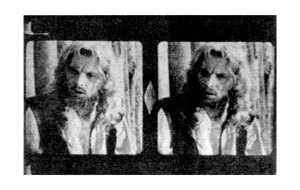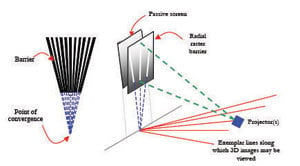The BBC’s recent decision to put its 3D TV venture on hold is yet another indication that all is not well with television’s foray into the third dimension. A number of factors have contributed to its current demise and these include a failure to properly accommodate the ways people behave when ‘watching’ TV - from the child who regularly switches attention between toys and screen, to the adult who multitasks. In every case those glasses get in the way and all too often gravitate to that dark space beneath the sofa.
Cinema audiences are more single minded and are generally intent on a truly immersive experience. They are therefore more willing to tolerate viewing glasses as an interim solution but look forward to the development of alternative technologies that will support the convenience of glasses-free (autostereoscopic) 3D.
In fact, glasses-free 3D cinema is not a futuristic vision - in Moscow back in 1941 it was reality, playing on a 5x3m screen:
‘The auditorium is plunged in darkness, except for a little lamp suspended from the ceiling by a long cord. But wait - an actor suddenly reaches out from the screen and draws the lamp towards him. How did he do it? As a matter of fact, there was no lamp left burning in the auditorium. It was simply an effect produced by the stereocinema... A juggler flings a ball straight at the audience, and those who happen to come within his line of vision blink and duck involuntarily...’ Ivanov (1941)
On show was the 40 minute 3D film, ‘Konsert’ and during a four month period some 500,000 people took the opportunity to enjoy autostereoscopic 3D. Unfortunately the venture could not have been more ill-timed, and it came to an abrupt halt in June when Germany and Russia became embroiled in total warfare.
On 20 February 1947 glasses-free 3D re-opened in Moscow. Significant developments in display technology were complemented by advances in the art and science of stereo photography. The 3D feature film ‘Robinson Crusoe’ was a sterling success:
‘...It was only when Crusoe in his shipwreck throws a rope to a drowning sailor that you get the first shock. The rope comes hurtling and curling right out of the screen into the darkness.... You duck. We all did. After that we were ready for anything... this luminous effect resembles the unearthly atmosphere of the Insect or Tropical Bird Houses in London Zoo. As if light were liquid. As if the heat were tangible... The depth is used cleverly to increase our sense of Crusoe’s loneliness...When he (Crusoe)goes down with fever, therefore, though little dialogue has been possible, he is a real person to us. Sensation in place of speech has placed us inside his head. We fight every inch of the way with him towards survival and recovery…A strikingly beautiful shot of a ship in full sail close inshore - the effect of stereoscopic photography on the canvas, rope and wood of a sailing ship cannot be described except in terms of goldsmith’s work....’ Macleod (1947)
 Stereo frames from Robinson Crusoe (1947)
Stereo frames from Robinson Crusoe (1947)
Our everyday perception of the 3D world is strongly influenced by small differences in the images presented to the two eyes. These arise because each eye sees the world from a slightly different vantage point and this is used by the visual system to give a vivid impression of depth.
In the case of stereo photography, a scene is photographed from two locations approximately separated by the distance between our eyes. If we then present these photos to the eyes in such a way that the left-hand photo can only be seen by the left eye and the right-hand photo only by the right eye, then the visual system fuses content and we perceive 3D.
In the case of glasses-based cinema and TV, the left and right views are encoded in some way and are simultaneously presented to all members of the audience. Viewing glasses serve a decoding function and ensure that the left and right stereo images are mapped to the intended eye.
This is a simple and cost-effective method of delivering 3D - provided that viewing glasses are deemed acceptable. Glasses-free 3D cinema poses some interesting challenges. Back in 1940, Dennis Gabor (inventor of holography) eloquently summarised two key functions of the display hardware.
Firstly a ‘multiplication’ function is needed, and this in effect makes multiple copies of the stereo output from the projection system. These are then distributed to each audience member by means of a ‘spreading’ function in such a way that the left and right stereo views are directed to the intended eyes.
The technology
The oldest method of implementing a projection-based glasses-free 3D display uses a parallax barrier comprising a set of interleaved transparent and opaque bands aligned vertically (akin to a picket fence - although the palings and gaps must be so narrow that they cannot be individually resolved by the eyes, and the palings must be non-reflective).
The barrier is located in front of a light diffusing screen and operates in such a way that the two images generated by the projector(s) are segmented into vertical strips and interleaved on the screen.
Light returning from the screen must also pass through the barrier, which now operates so as to make each set of strips visible from specific locations and gives rise to multiple viewing positions at a certain distance from the screen. Clearly for cinema the display technique must support viewing across the length and breadth of an auditorium, and in this respect the parallax barrier fails.
In the 1920s Edmond Noaillon undertook extensive research into glasses-free cinema. He recognised the limitations of the parallax barrier and developed the radial raster barrier, which was subsequently used by Semyon Pavlovich Ivanov and co-workers in the implementation of Russian glasses-free 3D cinema.
In this scenario, the transparent and opaque bands of the barrier are no longer parallel but form a fan-like structure and if extended meet at a common point. Both multiplication and spreading functions are carried out effectively - viewing being supported across both dimensions of the auditorium.

The radial raster barrier
Russian researchers recognised that the barrier is inherently inefficient in its transmission of light (all light falling onto the opaque bands is lost). Consequently, when autostereoscopic cinema reopened in 1947 the barrier was superseded by a radial lenticular approach - thereby enabling the formation of much brighter images. Within a few years, glasses-free 3D cinemas opened in Kiev, Leningrad and Astrakhan and continued successfully through to the 1960’s.
Success or failure
Glasses-based 3D cinema continues to represent the simpler solution and is able to accommodate more closely packed audiences. Furthermore, the challenges associated with glasses-free approaches become more taxing as screen width is increased. These would have been key factors that eventually caused the Russians to migrate to the glasses-based approach.
Our continued use of glasses-based technology is primarily driven by commercial considerations: it represents the most cost effective approach. In the case of TV it is important to recognise that 3D works well with only some forms of content. This suggests the need for display technologies that can seamlessly transition between 2D and 3D modes of operation - thereby supporting the infusion of 3D into 2D delivery.
In turn this implicitly necessitates a glasses-free approach able to support appropriate freedom in viewing positions. Furthermore, since TV audiences are usually in quite close proximity to the screen, accommodation and convergence issues (which can cause visual strain) cannot be cast to one side.
Such requirements - coupled with the creation of appropriate content - are essential to the success of 3D TV and may perhaps be most readily achieved through the use of techniques that better capitalise on the remarkable capabilities of our sense of sight.
In this respect, technologists have sometimes incorrectly assumed that binocular vision is the sole basis for 3D perception. Certainly the early pioneers of 3D cinema have demonstrated the practicality of delivering autostereoscopic 3D to quite large audiences. Armed with today’s materials, technologies, simulation tools and know-how, we are far better placed to implement viable and highly innovative glasses-free solutions.
Further reading
- Blundell, B.G., ‘On Aspects of Glasses-Free 3D Cinema ~70 Years Ago’
- Funk, W., ‘History of Autostereoscopic Cinema’, Proc. SPIE, Vol. 8288, (2012)
- Ivanov, S.P., ‘Russia’s Third Dimensional Movies’, American Cinematographer, pp. 212-213, (May 1941)
- Macleod, J., ‘Stereoscopic Film. An Eyewitness Account’, Monthly Film Bulletin, pp. 118-119, (1 October 1947)
- Valyus, N.A., Stereoscopy, The Focal Press, (1966)












